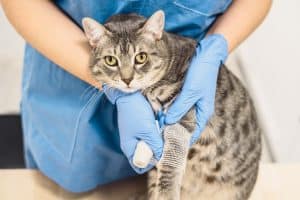
Four-Legged Heroes: Pet Blood Banks and the Battle for Awareness
“Most people don’t know they can donate their pet’s blood until their pet needs blood for lifesaving circumstances.” says Julie Bitautas, a Registered Veterinary Technician, Specialty Supervisor, and Blood Bank Coordinator at Evolution Veterinary Specialists in Lakewood, Colorado.
“People hear the words ‘blood bank’ or ‘blood transfusion’ for the first time when their pet is sick, but not often before that moment. Everyone knows there’s a shortage of human blood, but there is an even greater shortage of pet blood. Everything that happens in human medicine happens in veterinary medicine, too, yet folks don’t think about pet blood needs.” 
EVS aims to provide blood products for any pet hospital in the Denver area, and sometimes further. Many hospitals in the area require the use of blood from their own hospital on their terms, as they are trying to make sure the pets in their care are taken care of first.
EVS, however, provides blood to any pet hospital in the area. Their goal is to make sure no pet is euthanized or turned away if a pet owner can’t afford a blood transplant. Part of this goal is to make sure they also provide the knowledge for the veterinarians at other hospitals to use the blood correctly.
Julie began her career in the veterinary field 12 years ago in the Chicagoland area of Illinois before moving to Colorado. Early in her career, she saw many pet parents who had to choose between foregoing care or euthanasia for not having the finances or the blood available to save their pet. This broke her heart and simultaneously spurred her to take an interest in and develop a blood banking program. At that time, she worked at a specialty and emergency hospital iin which the employees would bring their pets to donate as needed, however, the clinic couldn’t provide a full program. So, Julie pushed for change. She grew the blood bank to support patients in need of blood products, not only in her hospital but any surrounding hospital that reached out when in need. In 2018, when Julie was given the opportunity to work at and establish the blood bank at EVS, her priority was to ensure the availability and affordability of their blood products. Since then, the EVS team has saved countless pets’ lives. However, a significant challenge remains: many people are unaware of the existence and importance of animal blood banks. Consequently, a crucial aspect of Julie’s role is to educate the public about this life-saving service, emphasizing that even their pets can become heroes through a simple blood donation.
How Does Blood Banking Work?
The banking of the blood at EVS is for dogs and cats. Banking blood for other kinds of companion animals (birds, ferrets, lizards, etc.) is not feasible due to the minimal amounts needed, as well as the unique requirements for storing different types of animal blood. EVS is, however, working on networking for these types of blood to be available as needed. For instance, they have two or three ferret owners who will bring their pets in when EVS needs a transfusion for another ferret patient.
Species-Specific Blood. Each species can give the same species blood, as each species has their own blood types. 
For instance, cats have blood types A, B, and AB:
Blood type A cats receive only A blood
Blood type B cats receive only B blood
Blood type AB cats can receive A, B, or AB blood
*EVS is currently looking for cats with Type B blood to bank, which is extremely rare. If you are in the Denver area and have a cat, please reach out to schedule an appointment!
Unlike cats, dogs have either a positive or negative blood type, which are the main markers for canine donors. Negative canine blood types are universal donors, and positive canine blood types are universal recipients.
Blood Donation Process. During canine blood donations, positive reinforcement with praise and treats is provided without sedatives if possible. If the dog becomes anxious, the appointment turns into more of a meet & greet, making the animal’s experience a positive one. About half of canine donors don’t require sedation. Cat donors typically get a “kitty burrito snuggle” with a vet tech, where they are wrapped in a blanket and held for 3-5 minutes while their blood is drawn, followed by a delicious snack of tuna as positive reinforcement. If a pet is very anxious or jumpy around the needle, a very mild calming sedative can be administered, which makes them happy, calm, and cuddly.
The Two Most Important Things to Know About Pet Blood Donations
- Your Dog or Cat is a Hero. For just 45 minutes, every other month (six times per year), your dog can save up to three dogs’ lives. On average, your dog’s blood donation could save 18 dogs per year. Similarly for cats, they would donate every 6-8 weeks. For every cat donation they can save up to two cats’ lives, or 12 cats’ lives per year.
- Blood bank donations help to screen your own pet’s health. A yearly free-to-you screening at EVS for the commitment of recuring blood donations each year would typically cost upwards of $700 for lab work at a typical veterinarian visit. This free screening catches a lot of illnesses and diseases that otherwise might go undiagnosed. A simple commitment of blood donation could save even your pet’s life.
If you live in the Denver area of Colorado and you are interested in scheduling an appointment for your dog or cat to donate blood at Evolution Veterinary Specialists, visit https://evolutionvet.com/resources/blood-bank/ or call (720) 510-7707 to learn more!
To find out if there is an animal blood bank service near you, we encourage our readers to reach out to your local emergency vets, specialty clinics, or any university that has a veterinary school.
 from Laurel Lewis
from Laurel Lewis



